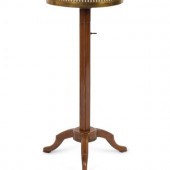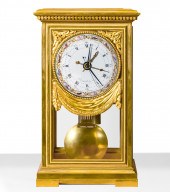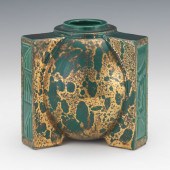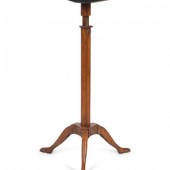Pricing Guides & Dictionary of Makers Marks for Antiques & Collectibles

A few examples of appraisal values for
EMAILLE
Search our price guide for your own treasures
-
 A Louis XVI Style Brass-Mounted
A Louis XVI Style Brass-Mounted Acajou Guéridon à Crémaillère 19th Century Height 30 x depth 10 inches. Property from a Michael Simon Designed Interior, Florida
A Louis XVI Style Brass-Mounted
A Louis XVI Style Brass-Mounted Acajou Guéridon à Crémaillère 19th Century Height 30 x depth 10 inches. Property from a Michael Simon Designed Interior, Florida -
 EXCEPTIONAL LOUIS XVI REGULATOR
EXCEPTIONAL LOUIS XVI REGULATOR WITH REMONTOIR D’éGALITé “ROYAL MODEL”, CIRCA 1785 Exceptional Louis XVI Regulator with Remontoir d’égalité “Royal Model”, circa 1785Clockmaker Robert Robin (1741-1799), the polychrome dial by Joseph Coteau(1740-1801), case attributed to Pierre-Philippe Thomire (1757-1843)Ormolou and glass case, hand-painted, jeweled and enameled porcelain dial with astrological zodiac cartouches, signed Coteau and Robin Hr.du Roy, pierced gilt brass hands, blued steel pointers for the mean time and calendar indications, sweeps second hand. Movement of month duration with calendar, equation of time, with remontoire, re-wound via Robin's pulley system, constant force, Graham dead-beat escapement, nine-rod compensated pendulum, striking on the solar hour and half hour on a single bell.Commentary: The inventory of the Château de Saint-Cloud made in January 1794 features two clocks in Marie-Antoinette’s pièce des nobles (room for receiving visiting nobility) that were not there during the previous inventory of 1789. One of them is probably the present example made by Robert Robin, clockmaker to the king, who signed the dial. However, the queen probably never saw this clock as she was not permitted to visit her castle after 1791. Around 1860, the clock was still, or again, at Saint-Cloud, in the bedroom of Empress Eugénie, who surrounded herself with objects that belonged, or were thought to have belonged, to Marie-Antoinette.Robert Robin (French, 1741-1799)was one of the finest clockmakers in France during the last quarter of the eighteenth century. He received a number of royal appointments during the reign of Louis XVI and managed to retain his standing during and after the French Revolution. He maintained the highest standards in design and construction, engaging the best cabinetmakers for his cases and the finest enamel painters for his dials. He served as the Horloger du duc Chatrtres (1778), Valet de Chambres-Horloger Ordinaire du Roi (1783), Horloger de Monsieur (1785), Valet de Chambres-Horloger Ordianire de la Reine (October 1, 1786), Horloger de la Répulique (1794), Horloger du Directoire (1796). His signature reads: “Robin Hr.du Roy.” This elegant design, which he introduced around 1780, was his most successful model.Joseph Coteau (1740-1801)regarded as the greatest enameler of all time, supplying dials for the most eminent horologists, including Antide Janvier (1751-1835), Robert Robin (1742-1809) and Ferdinand Berthoud (1727-1807). In 1780, Coteau was appointed ‘Peintre-émailleur du roi et de la Manufacture Royale de Sèvres, and by 1784 his production was considerable, receiving 4520 livres from the Manufacture de Sèvres for executed commissions.Examples of his work can be found in a number of European museums, including Mobilier National, Musee des Arts Decoratifs, Paris; Carnavelet Museum, Dijon Museum, and in London at the Wallace Collection and Victoria and Albert Museum.Watch Video
EXCEPTIONAL LOUIS XVI REGULATOR
EXCEPTIONAL LOUIS XVI REGULATOR WITH REMONTOIR D’éGALITé “ROYAL MODEL”, CIRCA 1785 Exceptional Louis XVI Regulator with Remontoir d’égalité “Royal Model”, circa 1785Clockmaker Robert Robin (1741-1799), the polychrome dial by Joseph Coteau(1740-1801), case attributed to Pierre-Philippe Thomire (1757-1843)Ormolou and glass case, hand-painted, jeweled and enameled porcelain dial with astrological zodiac cartouches, signed Coteau and Robin Hr.du Roy, pierced gilt brass hands, blued steel pointers for the mean time and calendar indications, sweeps second hand. Movement of month duration with calendar, equation of time, with remontoire, re-wound via Robin's pulley system, constant force, Graham dead-beat escapement, nine-rod compensated pendulum, striking on the solar hour and half hour on a single bell.Commentary: The inventory of the Château de Saint-Cloud made in January 1794 features two clocks in Marie-Antoinette’s pièce des nobles (room for receiving visiting nobility) that were not there during the previous inventory of 1789. One of them is probably the present example made by Robert Robin, clockmaker to the king, who signed the dial. However, the queen probably never saw this clock as she was not permitted to visit her castle after 1791. Around 1860, the clock was still, or again, at Saint-Cloud, in the bedroom of Empress Eugénie, who surrounded herself with objects that belonged, or were thought to have belonged, to Marie-Antoinette.Robert Robin (French, 1741-1799)was one of the finest clockmakers in France during the last quarter of the eighteenth century. He received a number of royal appointments during the reign of Louis XVI and managed to retain his standing during and after the French Revolution. He maintained the highest standards in design and construction, engaging the best cabinetmakers for his cases and the finest enamel painters for his dials. He served as the Horloger du duc Chatrtres (1778), Valet de Chambres-Horloger Ordinaire du Roi (1783), Horloger de Monsieur (1785), Valet de Chambres-Horloger Ordianire de la Reine (October 1, 1786), Horloger de la Répulique (1794), Horloger du Directoire (1796). His signature reads: “Robin Hr.du Roy.” This elegant design, which he introduced around 1780, was his most successful model.Joseph Coteau (1740-1801)regarded as the greatest enameler of all time, supplying dials for the most eminent horologists, including Antide Janvier (1751-1835), Robert Robin (1742-1809) and Ferdinand Berthoud (1727-1807). In 1780, Coteau was appointed ‘Peintre-émailleur du roi et de la Manufacture Royale de Sèvres, and by 1784 his production was considerable, receiving 4520 livres from the Manufacture de Sèvres for executed commissions.Examples of his work can be found in a number of European museums, including Mobilier National, Musee des Arts Decoratifs, Paris; Carnavelet Museum, Dijon Museum, and in London at the Wallace Collection and Victoria and Albert Museum.Watch Video -
 WILLY WUILLEUMIER PARIS ART DECO
WILLY WUILLEUMIER PARIS ART DECO CERAMIC TRIPOD VASE 6" x 6 ½" x 6 ½" "Vase céramique émaillée or vert craquelé." Tripod Art Deco ceramic vase, incised design on sides, mottled sea wave and gilt glaze with craquelure finish, marked on the bottom.
WILLY WUILLEUMIER PARIS ART DECO
WILLY WUILLEUMIER PARIS ART DECO CERAMIC TRIPOD VASE 6" x 6 ½" x 6 ½" "Vase céramique émaillée or vert craquelé." Tripod Art Deco ceramic vase, incised design on sides, mottled sea wave and gilt glaze with craquelure finish, marked on the bottom. -
 A Louis Philippe Acajou Gueridon
A Louis Philippe Acajou Gueridon a Cremaillere 19TH CENTURY Height 31 x diameter 13 inches. Property of a Miami Private Collector
A Louis Philippe Acajou Gueridon
A Louis Philippe Acajou Gueridon a Cremaillere 19TH CENTURY Height 31 x diameter 13 inches. Property of a Miami Private Collector
...many more examples with full details are available to our members - Learn more


